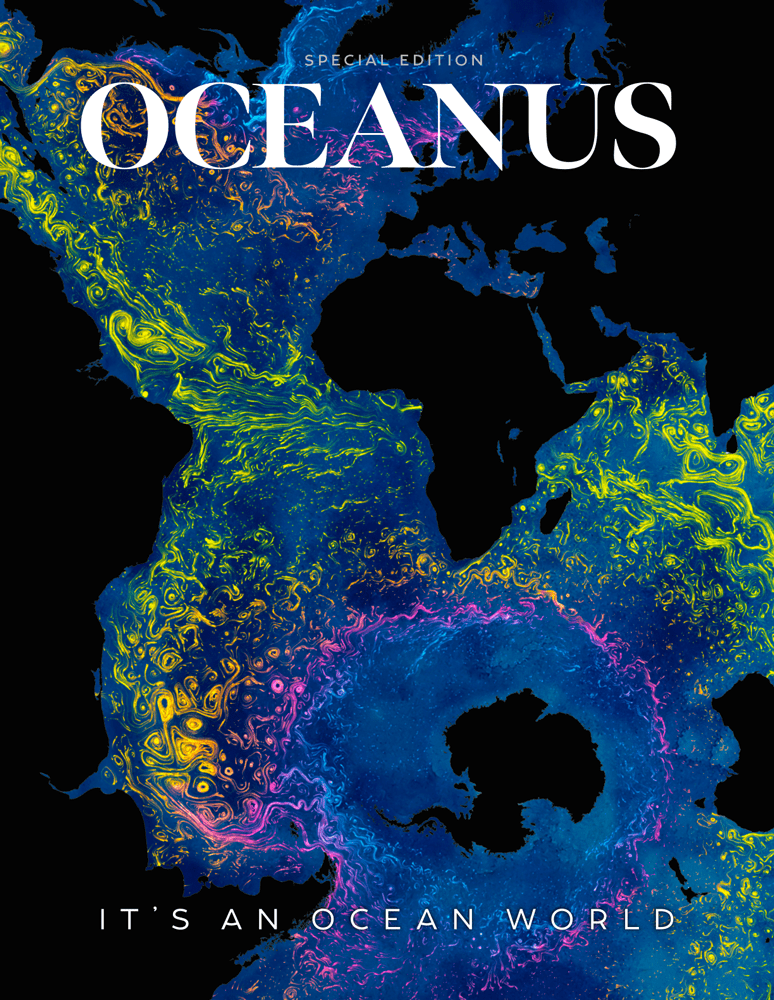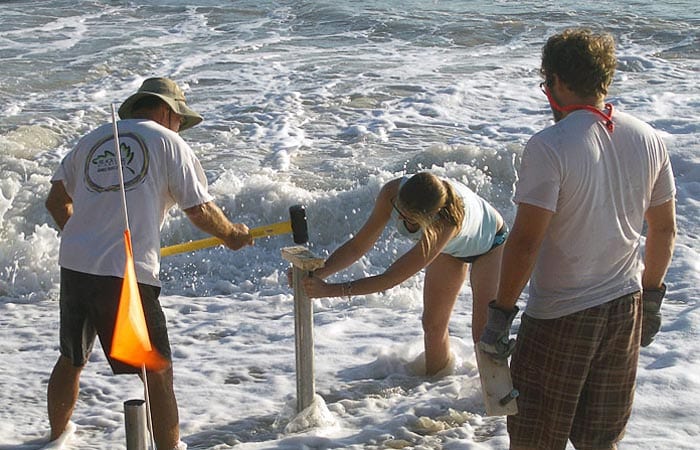
(Photo by Steve Elgar, Woods Hole Oceanographic Institution)
Shifting Sands and Bacteria on the Beach
Does ever-moving sand transport microbes along with it?
Most coastal communities in the United States test the water at beaches for the presence of bacteria. But they don’t routinely test the sand. Does sand also harbor bacteria?
Until recently, few people have worried about that possibility. We encounter potentially harmful microbes all the time, and they don’t usually make us sick after casual exposure such as walking on contaminated sand, unless our immune system is suppressed or a break in our skin gives the organisms easy entry into our bodies.
“But how often do you go swimming or sit in the sand with some sort of nick on you?” said Britt Raubenheimer, a physical oceanographer at Woods Hole Oceanographic Institution (WHOI). “It doesn’t take much. That’s what happened with Steve.”
She was referring to her colleague, Steve Elgar, who in the early 2000s suffered an infection from a particularly nasty strain of antibiotic-resistant bacteria that he was exposed to on a beach. It got into his system through a small cut on his leg, and he ended up spending three days in the hospital.
Then in 2003, Elgar and Raubenheimer witnessed a beach community’s worst nightmare: A sewer pipe in a shoreline bluff ruptured, sending 300,000 gallons of raw sewage onto a popular beach just below the Torrey Pines Municipal Golf Course in San Diego. The two scientists happened to be in the area studying how surf, winds, and tides move sand around and continually re-shape the beach. The spill soon became a can’t-look-away-from-the-wreck kind of scene. San Diego authorities decided the best way to deal with the mess was to bring in bulldozers to pile up berms of sand around it, in an attempt to isolate it from the rest of the beach.
“Their idea was to make this sort of a cesspool, and the sewage would slowly filter through the sand before it got to the ocean,” said Raubenheimer.
But she and Elgar knew the berms were not likely to last long. Their research has shown that when the tide comes in, a hole in the sand 6 feet deep and 30 feet across can refill with sand in about two hours, as its walls collapse inward and new sand is deposited.
“So then you wonder: What happens when the waves come up and bury this stuff under the sand?” Raubenheimer said. “And maybe it’s buried by clean sand, but then that erodes? That got us thinking about all sorts of questions.”
Questions such as: What kinds of disease-causing organisms live in the sand? How long can they survive there and still be able to infect people? And, closer to their own area of expertise, can movement of the sand bring buried microbes back to the surface and carry them to other parts of the beach or into the water?
Between the cracks
After the San Diego spill, the questions became too urgent to put off any longer. Elgar and Raubenheimer invited WHOI biologist Rebecca Gast to join them in a project to find out whether beach sand might serve as a reservoir of microbes that waves, tides, or storm surges might later carry into the water.
Gast studies microbial ecology in a variety of settings, including beaches, and has done public-information programs about beach closures. She welcomed the chance to combine her expertise in microbiology with physical oceanography techniques exploring the dynamics of water and sand. At the time, there had been no studies of how many microbes are in the sand, how long they live, or how far they could move from their initial location.
“A couple of studies have shown that you do have an increased risk of disease when you play in the sand, but that’s all,” she said.
Before they could launch the project, the researchers first had to secure funding for it—and that turned out to be a struggle. Elgar said the U.S. Environmental Protection Agency is dealing with hefty budget cuts and is hard-pressed to maintain its current water-quality programs, let alone expand into new areas. The National Science Foundation (NSF), which has funded physical oceanography research by Elgar and Raubenheimer and microbial research by Gast, was not interested in a project combining the two.
“The three of us sent a proposal to NSF and the program manager asked us to withdraw it,” said Elgar. “He said, ‘No, I’m not interested.’ ”
The scientists think their proposal fell between cracks in the system in which funds are granted by programs in traditional scientific disciplines. The proposed research didn’t have enough physics to satisfy physical oceanography reviewers, and for basic research biologists, it was too directed toward human health issues.
“The public is interested in beach closures and public health, but the scientific community that reviews these things still has difficulty with the interdisciplinary aspect,” said Raubenheimer.
To make the project more appealing, the team trimmed costs by piggybacking this project onto research Elgar and Raubenheimer were already doing on the beach at the U.S. Army Corps of Engineers’ Field Research Facility in Duck, N.C. Since they and their equipment would already be on site, the new grant wouldn’t have to pay those travel and shipping expenses.
In the end, three local sources stepped up to support the research: the WHOI Coastal Ocean Institute, a Mellon Joint Initiatives Award at WHOI, and the Woods Hole Centers for Oceans and Human Health, a joint venture of WHOI and the Marine Biological Laboratory that was funded by NSF and the National Institute of Environmental Health Sciences.
The core of the matter
The team came up with a simple but powerful experiment to find out whether moving sand carries bacteria with it. They planned to sample during one of the early fall storms that affects the Outer Banks, when the beach would show measurable rearrangements of sand. They marked three spots on the beach at Duck: one at the high-tide mark, one several yards downshore in the mid-tide zone, and a third several yards farther out, but still in the mid-tide zone. The high-tide spot was covered by water briefly during each tidal cycle; the mid-tide areas were submerged for part of each day and exposed to the air for part of each day.
At each spot, the scientists drove coring tubes into the sand. They pulled out the tubes with cores of sand about 100 centimeters (just over 3 feet) long and 7.5 centimeters (about 3 inches) across and froze them for transport home.
Soon after the cores were removed from the ground, the narrow holes refilled with sand. Two days later, the team took another set of cores from near the same spots. Two days after that, they took a third set of cores. During the experiment, they also measured the height of the beach surface each day, using a highly sensitive GPS device, so they could determine how much sand was removed from or added to the beach between sampling days.
Back in her lab at WHOI, Gast analyzed sand from specific depths in each core for the presence of bacterial DNA. She looked for DNA from Enterococcus faecalis, a species that comes from feces and can cause illness in people. Because the study area had not suffered a contamination event recently, the chances of finding E. faecalis DNA were low. So Gast also looked for DNA from free-living, naturally occurring enterococci bacteria. They are not known to be harmful to humans, but they are fairly abundant in the environment, and they could indicate whether sand movements can redistribute microbes of that size.
Analyzing the sand
The scientists’ findings underscored just how dynamic the beach was. Due to an offshore hurricane, there was some rain and high waves at the start of the week they took the samples, but those diminished rapidly after the storm passed. During the five-day study, a lot of sand moved. Nine centimeters (3.5 inches) of sand piled atop the high-tide site between the first and second sample days and again between the second and third. Both mid-tide sites lost 9 to 11 centimeters (3.5 to 4.3 inches) of sand during the first interval and gained even more sand during the second.
And that’s just measuring how high the surface of the beach was. In one case, the sand 60 centimeters below the surface changed from fine-grain to coarse-grain. In other words, tides and waves had replaced the sand at that spot with new sand to a depth of at least 2 feet.
Gast didn’t find DNA from E. faecalis in any of the samples, but about two-thirds of them—even those many centimeters deep in the cores—had enterococcal DNA. Most significantly, areas that did not have bacterial DNA on an earlier day did have it on a later day. The additional sand that raised the level of the beach also tested positive for bacterial DNA. Clearly, enterococcal DNA was being moved with the sand and was not washed away in the surf. The research team concluded that sand that can move harmless enterococci could also probably move E. faecalis and other disease-causing species.
When it came time to publish their results, the scientists once again faced reviewers unable or unwilling to consider interdisciplinary projects.
“We sent it out to a microbiology journal, and they just flung it right back at us,” said Gast. “They didn’t want to see it. There wasn’t enough microbiology in it.”
The paper got a more enthusiastic reception from the editor and reviewers at the journal Continental Shelf Research, which published it in June 2011.
Dry ≠ Clean
One of the study’s intriguing findings is that even sand below the surface at the high-water mark wasn’t free of bacterial DNA, which might surprise those of us who tend to think of dry sand as somehow “cleaner” than wet sand, clay, or mud.
“It’s ‘dry,’ but this is not the great Libyan Desert,” said Elgar. “There’s dew. You’re on the beach, so there’s spray. It feels dry to us, but there are still water molecules in there. Bacteria don’t need much water to live.”
“The dry sand is worse than wet sand, in some ways,” said Raubenheimer. If the area hasn’t been contaminated recently and the water is clean, “you’re better off being at the low-tide area where the sand has been washed by the waves quite a bit.”
That’s consistent with work Elizabeth Halliday, a graduate student in the MIT/WHOI Joint Program who is advised by Gast, did on beaches at Provincetown, Mass., in 2010.
“Elizabeth found that the dry sand tended to get higher numbers of bacteria,” said Gast. “The wet sand, where it was always wetted throughout the tidal cycles, tended to have much lower numbers.”
Listen to your mom
The researchers stressed that the mere presence of bacterial DNA does not mean that playing in the sand is dangerous.
“The jury’s still out,” said Elgar. Additional research might conclude that bacterial contamination of sand is not a big health issue, he said.
Gast added that their findings might turn out to be most useful for beach managers wanting to predict which beaches should be closed after a major contamination event like the big spill in San Diego. “We might conclude that sand contamination isn’t a big deal that we need to test for all the time on all beaches, but if you know there’s been 300,000 gallons of raw sewage, here are some tests that you can use to check the sand, not just the water,” she said.
In the meantime, the researchers urge beachgoers to use common sense, which in this case is pretty much what your mother told you when you were a kid.
“We don’t tell people not to go to the beach or not to dig in the sand,” said Gast. “But clean your hands off before you eat. Don’t just dust the sand off. Wash your hands. And if you were buried in sand, rinse off afterward.”
Slideshow
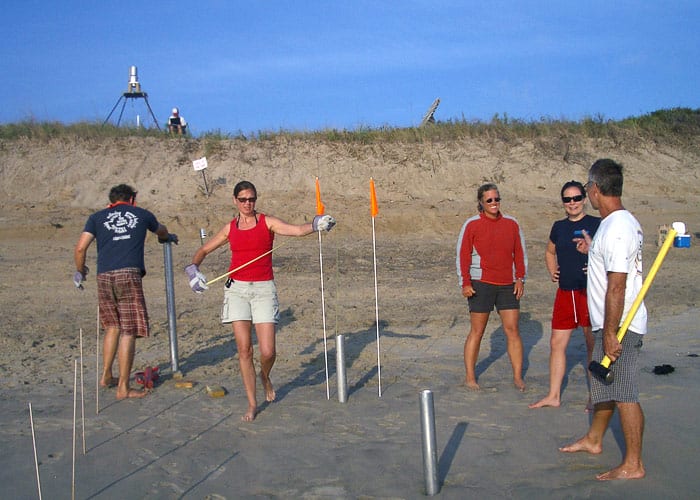
Slideshow
 WHOI microbial ecologist Rebecca Gast checks the distances between sample sites on the beach at Duck, N.C., as WHOI physical oceanographer Britt Raubenheimer (red jacket) talks with other colleagues. The researchers took samples of sand from three spots on the beach, from mid-tide up to the high-tide mark, to find out whether the sand harbored DNA from bacteria and whether wind and waves that moved the sand also moved the DNA (and presumably the bacteria). (Photo by Steve Elgar, Woods Hole Oceanographic Institution)
WHOI microbial ecologist Rebecca Gast checks the distances between sample sites on the beach at Duck, N.C., as WHOI physical oceanographer Britt Raubenheimer (red jacket) talks with other colleagues. The researchers took samples of sand from three spots on the beach, from mid-tide up to the high-tide mark, to find out whether the sand harbored DNA from bacteria and whether wind and waves that moved the sand also moved the DNA (and presumably the bacteria). (Photo by Steve Elgar, Woods Hole Oceanographic Institution)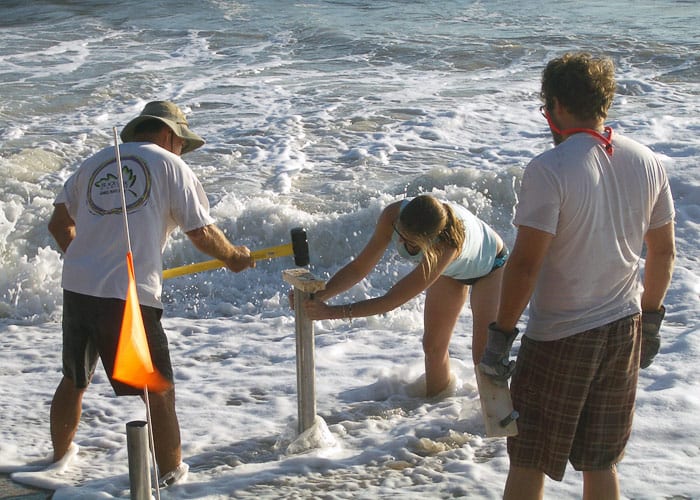 Bill Boyd, a senior engineer at Scripps Institution of Oceanography, drives a coring tube into the sand as WHOI microbial ecologist Rebecca Gast steadies the tube and WHOI research associate Levi Gorrell looks on. Each tube collected a core of sand about 100 centimeters long. Gast analyzed samples from different depths within each tube for the presence of bacterial DNA. (Photo by Steve Elgar, Woods Hole Oceanographic Institution)
Bill Boyd, a senior engineer at Scripps Institution of Oceanography, drives a coring tube into the sand as WHOI microbial ecologist Rebecca Gast steadies the tube and WHOI research associate Levi Gorrell looks on. Each tube collected a core of sand about 100 centimeters long. Gast analyzed samples from different depths within each tube for the presence of bacterial DNA. (Photo by Steve Elgar, Woods Hole Oceanographic Institution)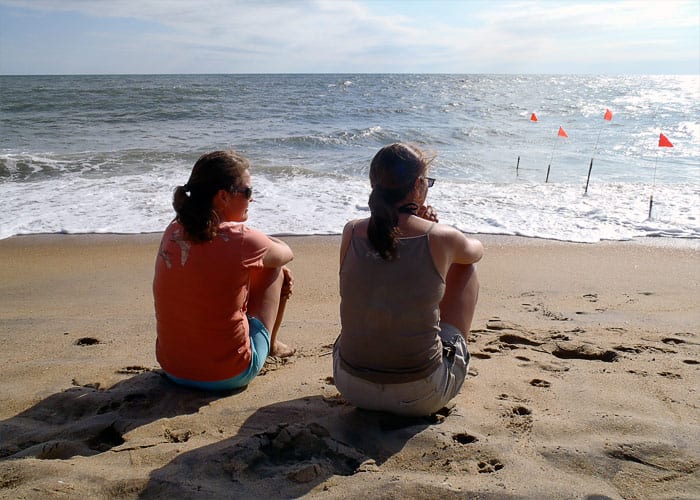 MIT/WHOI Joint Program student Elizabeth Halliday (left) and microbial ecologist Rebecca Gast watch and wait as the tide recedes past their sample sites, marked by pennants. The scientists analyzed core samples from each site for the presence of bacterial DNA and found that sand added to the beach by wind and waves often carried bacterial DNA with it. (Photo by Steve Elgar)
MIT/WHOI Joint Program student Elizabeth Halliday (left) and microbial ecologist Rebecca Gast watch and wait as the tide recedes past their sample sites, marked by pennants. The scientists analyzed core samples from each site for the presence of bacterial DNA and found that sand added to the beach by wind and waves often carried bacterial DNA with it. (Photo by Steve Elgar)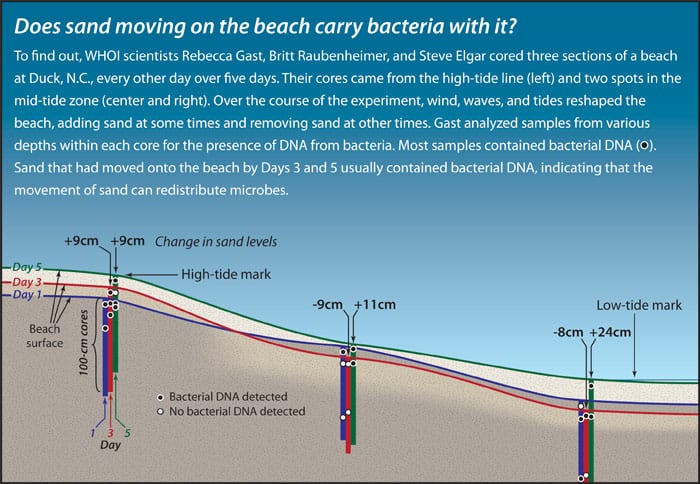 (Illustration by Jack Cook, Woods Hole Oceanographic Institution)
(Illustration by Jack Cook, Woods Hole Oceanographic Institution)
Related Articles
Featured Researchers
See Also
- Beach closure interactive Kid-friendly display on beach closures
- Rebecca Gast's lab
- Britt Raubenheimer and Steve Elgar's lab
- Testing the Waters and Closing the Beaches An article on beach closure research by MIT/WHOI graduate student Elizabeth Halliday from Oceanus magazine
- Protecting Public Health by Preventing Pollution from Oceanus magazine
- Where the Surf Meets the Turf An article by Elgar and Raubenheimer from Oceanus magazine
- No Day at the Beach An article on Elgar/Raubenheimer research from Oceanus magazine
- Shaping the Beach, One Wave at a Time An article by Britt Raubenheimer from Oceanus magazine
- Centers for Oceans and Human Health
